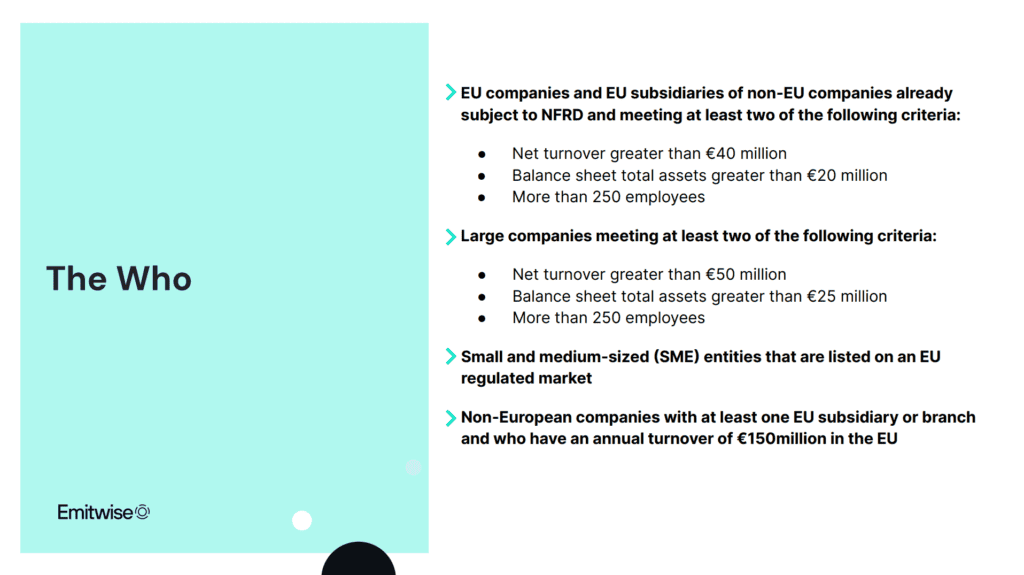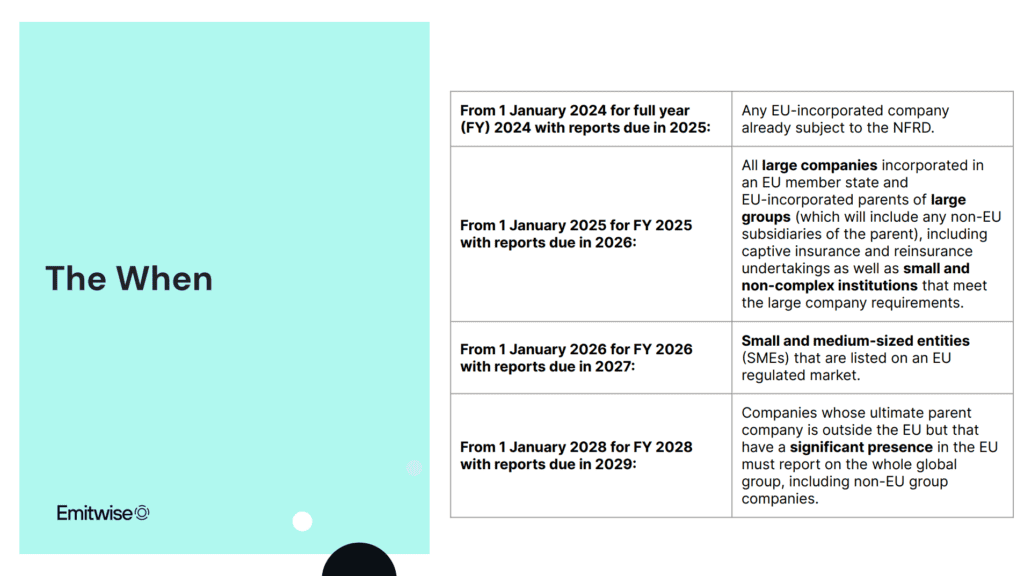Webinar Write Up: Are you ready to comply with CSRD? Or should you be postponing your efforts?
If you would like to watch the on-demand webinar, you can do so here.
The short answer? No. All businesses within the EU or based outside of it stand to gain nothing by doing nothing and have everything to gain from proactively seeking compliance.
But we aren’t saying it’s easy. The scope and rigour of the CSRD’s reporting requirements are unprecedented. Fortunately, we’ve read it back to front, and there are many opportunities to grasp by making sure you’re positioned to comply from the start.
So, where do you start? There’s no better place than the fundamentals. That’s where we began in our recent webinar, where we called on companies to get up early and hit the road to compliance before the traffic gets too heavy.
The Fundamentals of the CSRD
The Who: Scope
Perhaps the most fundamental question is: ”Does all this really apply to me?”. After all, if it doesn’t, you really don’t need to do very much. We’ve found this is the number one question from non-EU companies. The answer? If they have a subsidiary in the EU with a net turnover that exceeds €150 million then, yes, they have to comply.
For companies in the EU, the first thing to check is the Non-financial Reporting Directive (NFRD). If you’re subject to it, you’ll also need to comply with the CSRD. Here is the full list of who the CSRD applies to:

The What: Standards
The law covers 12 standards across 3 pillars that consider the full ESG spectrum. It’s no wonder that some businesses find compliance daunting. As ESRS E1 on climate change is a mandatory module, understanding it is a good first step to achieving compliance.
The biggest pillar is Environment, as it covers 5 of the CSRD’s 12 standards. The modules are designed to help stakeholders understand how the reporting company intends to transition to a sustainable economy. This will require tracking progress and hitting targets, which is going to require accurate data and the ability to demonstrate improvements.
More On What: Underlying Messages
Each module on the CSRD has some underlying messages that are worth understanding. It’s useful to consider the strategy you might use to achieve the goals set out in the individual modules, as well as how you intend to be transparent in how you are working to reach your targets.
Companies must keep these aspects in mind when complying with the CSRD:
- Strategy: Businesses should demonstrate that they’re always looking forward by thinking about climate targets and how they plan to achieve them with clear documentation to prove it. Sustainability should be a part of the company’s DNA, including the board and the management team.
- Track Record: This is the evidence used to back your strategy up. Make sure you’ve got plenty of qualitative and quantitative data as evidence. You’ll need to articulate potential impacts on the company and its supply chain and identify the scope of reporting. How far will you take compliance? Always ensure your reporting is aligned with ESRS 1&2, as those guidelines inform the entire CSRD.
The When
For businesses that are already subject to the NFRD, we’ll be expecting to see the first round of reporting by January 2025. Here’s how the timeline will look for each business the CSRD applies to:

The Why
The EU is setting the standard for mandatory reporting by opening it up to metrics we’ve never seen before. This should inspire other countries to adopt similar reporting structures.
For businesses, this means adhering to 3 metrics in their CSRD reporting:
- Consistency: The NFRD was rarely explicit in what it asked of businesses, creating a flexible scope that led to inconsistent reporting. The CSRD has been explicitly designed with detail and granularity in mind. Alignment with other respected global standards is key, including the TCFD and the ISSB, as this allows for company comparisons and a level playing field. It will be much easier to see who’s falling behind and who’s pulling their weight.
- Validation: This assessment comes with heavier scrutiny. All information provided must be audited independently. Sustainability must be as granular as finance to support investor and consumer decisions.
- Representation: There are no surprises here. With sustainability as a primary concern of investors and consumers, businesses need to provide evidence, comply, and act on their reporting. The results will impact your branding. PWC reports that 75% of investors scrutinise ESG, while Deloitte has said that 1 in 3 consumers have chosen not to buy over ESG and sustainability concerns.
Key Concepts in CSRD Reporting
- Double materiality: When a business reports data, it needs to assess the risks and opportunities it faces, including impacts on people and the planet, such as deforestation and flooding.
- Auditing and assurance: Everyone will need it as we transition from limited assurance to reasonable assurance. Businesses must cope with more depth as they align with financial reporting, where reasonable assurance is used as a standard.
- Digital tagging: Everything will need to be provided through a single access system, so CSRD data needs to be digitally tagged for logging with CSRD authorities.
- Looking in both directions: Historical and future data are required, so businesses must ensure their data ties back to their targets and future strategies.
More on the “E” Because That’s Our Thing
The main takeaway from ESRS is that scope 3 is mandatory. The E1 module clearly states this and prompts our customers to ask: ” What does this mean for me?”.
To better answer the question, we start by asking our customers: “What expectations and opportunities do you gain from proactive compliance?”.
You won’t be able to fulfil the CSRD’s goals without mapping your supply chain. The CSRD assumes you’ve mapped your supply chain as a prerequisite to compliance with ESRS E1. Mapping the supply chain means:
- Understanding where your suppliers are
- Knowing where the emissions hotspots in the supply chain are
- Measuring emissions hotspots to understand their nature
The Correct Response to New Challenges
All of the above are opportunities to increase operational excellence and efficiency. In particular, be on the lookout for:
- Decreased operational costs
- Increasing availability of inventories
- Opportunities to strengthen the resilience of the supply chain and your balance sheet
- Opportunities to nurture relationships with suppliers so you can better collaborate on initiatives
Often, you might find that most suppliers aren’t mature or confident enough to meet their targets and, therefore, meet yours. Many don’t have targets at all, or they aren’t aggressive enough to meet yours. When it comes to supply chain and emissions, suppliers need a helping hand, as full supply chain coverage of backed-up emissions targets is a requirement of CSRD compliance.
We make scope 3 compliance as simple as possible with a 5 step program for procurement:
- Measure emissions in the supply chain.
- Screen your suppliers so you know who’s taking what steps.
- Engage them all by collecting information from mature suppliers and validating it, as well as helping those newer to emissions data collection.
- Inform procurement with gathered insights. Who’s ahead, and who’s behind? Who’s business critical and needs working with? Who’s no longer a match for your business?
- Report activities and reductions annually.
How to Calculate?
Most businesses use spend-based emission factors to show how their emissions evolve. Businesses need to reach a position where they can grow and expand. Transparent and informed reporting should help your business stay compliant and simultaneously strengthen your business using everything you’ve learned so far.
If You Aren’t CSRD-Ready, Here’s How to Get There
Make sure your CSRD data ducks are in a row. Your data has to be organised, reportable and auditable. To inform targets and roadmaps, you must get the baseline right from the start, so experts are essential. You can take the following steps:
- Decide which entities in the business are responsible for the CSRD and work with CSRD experts.
- Set your reporting strategy, which will include double materiality. Determine which sub-elements of the CSRD are most relevant to the business. Expert advice is key in this area.
- Map your value chain. Where in scope 3 do I need to take action? Start by understanding your scope 3 emissions and identifying hotspots.
- Conduct a gap analysis and create roadmaps. Where is the most intervention needed?
- Choose how you’ll report. Which digital tools will you need for reporting? Your tools must align with financial reporting to keep up with the CSRD.
Emitwise supports organisations with target-setting aligned with standards such as the Science-Based Targets initiative. Setting sub-targets at facility and supplier levels will quickly help you gain coverage for comprehensive reporting.
Once you have that, you’ll need to set a roadmap to 2030, 2040, and 2050. Emitwise can provide additional help with a flight path for those targets and demonstrate how your initiatives support your goals. Even better, they can show how suppliers can help.
Q&A: You asked, and we answered…
Is the CSRD postponed? What’s the truth behind the headlines?
The headlines about the CSRD’s postponement are exaggerated and irresponsible. It’s only the sector-specific guidelines that have been pushed back. They’ll be useful, but the general guidance is still out there. Companies still have to know what they’re doing regardless of guidance. Any postponement is a case of more work, not more time.
Where are the CSRD’s teeth?
Enforcement is flexible and can work on a company-by-company basis. It can include hefty fines, public announcements for reputational damage, operational realignment, and more.
How do you get audit-ready?
Identify every stakeholder included in emissions calculations. This includes everyone who owns data in the organisation: facility managers, the procurement team, and logistics managers. In particular, get the finance team involved, as they already understand audits! Check each calculation step to get your data ducks in a row. Document the entire end-to-end process for the auditor, so you’re always ready to answer questions.
Should the larger non-EU companies be rushing too?
Whether you decide to be a proactive or reactive business is up to you. The sooner you get started, the more you can capitalise on the business benefits. It’s possible that you’re being asked by stakeholders to do these things already.
What percentage of suppliers must take part? How deep into scope 3 do you need to go?
CSRD aligns with the GHG protocol, but the more granular your scope 3 calculations are, the more you can see the results of scope 3 initiatives. Aim for calculations that are as granular as possible within scope 3.
You can learn more about the Emitwise approach to scope 3 accuracy here.




